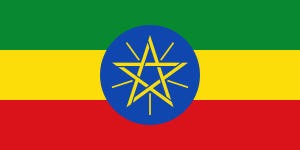Ethiopian National Defence Forces
| Ethiopian National Defense Force | |
|---|---|

|
|
| Service branches | Ethiopian Army Ethiopian Air Force Ethiopian Navy (1955–96) |
| Leadership | |
| Commander-in-Chief | Prime Minister Hailemariam Desalegn |
| Minister of Defence | Siraj Fergessa |
| Chief of General Staff | General Samora Yunis |
| Manpower | |
| Military age | 16-49 years old |
| Available for military service |
38,794,315, age 16–49 (2015) |
| Fit for military service |
24,757,344, age 16–49 (2015) |
| Reaching military age annually |
1,949,125 (2015) |
| Active personnel | 182,500 (2015) |
| Reserve personnel | 0 |
| Expenditures | |
| Budget | $330 million |
| Percent of GDP | 0.8% (2015 est.) |
| Related articles | |
| History |
British Expedition to Abyssinia Ethiopian–Egyptian War Mahdist War First Italo-Ethiopian War Second Italo-Ethiopian War World War II Korean War United Nations Operation in the Congo Eritrean War of Independence Ogaden War 1982 Ethiopian–Somali Border War Ethiopian Civil War Eritrean–Ethiopian War War in Somalia (2006–09) |
The Ethiopian National Defense Force (ENDF) is the military of Ethiopia. Civil direction of the military is carried out through the Ministry of Defense, which oversees the ground forces, air force, as well as the Defense Industry Sector. The current defense minister is Siraj Fergessa.
The size of the ENDF has fluctuated significantly since the end of the Ethiopia-Eritrea war in 2000. In 2002 the Ethiopian Defense Forces had a strength of approximately 400,000 troops. This was roughly the same number maintained during the Derg regime that fell to the rebel forces in 1991. However, that number was later reduced, and in January 2007, during the War in Somalia, Ethiopian forces were said to comprise about 300,000 troops. In 2012, the IISS estimated that the ground forces had 135,000 personnel and the air force 3,000.
As of 2012, the ENDF consists of two separate branches: the Ground Forces and the Ethiopian Air Force. Ethiopia has several defence industrial organisations that produce and overhaul different weapons systems. Most of these were built under the Derg regime which planned a large military industrial complex. The ENDF relies on voluntary military service of people above 18 years of age. Although there is no compulsory military service, armed forces may conduct call-ups when necessary and compliance is compulsory.
Being a landlocked country, Ethiopia today has no navy. Ethiopia acquired a coastline on the Red Sea in 1950 and created the Ethiopian Navy in 1955. Eritrea's independence in 1991 left Ethiopia landlocked again, but the Ethiopian Navy continued to operate from foreign ports until it finally was disbanded in 1996.
The Ethiopian army's origins and military traditions date back to the earliest history of Ethiopia. Due to Ethiopia's location between the Middle East and Africa, it has long been in the middle of Eastern and Western politics, and has been subject to foreign invasion and aggression.In 1579, the Ottoman Empire's attempt to expand from a coastal base at Massawa was defeated. The Army of the Ethiopian Empire was also able to defeat the Egyptians in 1868 at Gura, led by Ethiopian Emperor Yohannes IV. Clapham wrote in the 1980s that the "Abyssinians [had suffered] from a 'superiority complex' which may be traced to Gundet, Gura and Adwa".
...
Wikipedia
